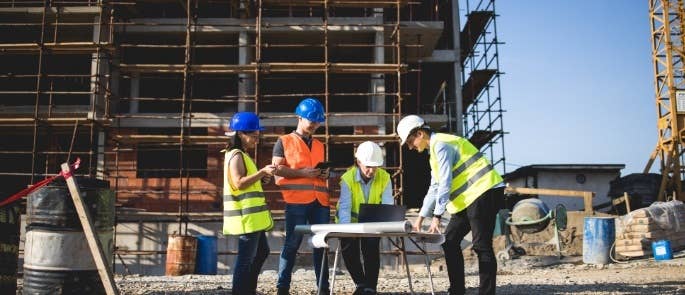One of the basic and well-known ways construction crews use to stay safe at the construction site is using hi-viz vests.
Additionally, sites incorporate barricades to prevent access to areas of danger or zones where workers are exposed to falls and accidents.
However, technology is also used to improve communication and enhance construction site safety. Here’s how that is being achieved.
1. Smart Sensors
Construction sites have a lot of noise and there are many distractions to bear with. These increase the risk of accidents beyond the levels hi-viz, barricades, and other restrictions can help. Sensors are used to monitor situations where workers are exposed to danger either in motion or static.
They also help prevent fires and accidents related to gas leaks, toxins, and other threats that are hard to detect with human eyes or other senses. One piece of equipment that are getting a smart update are rubber speed bumps because they can tell vehicles in the area movement patterns and speed.
Detecting these early enough helps to secure or evacuate workers before accidents can occur. Smart sensors can also be used to prevent impending dangers from moving or falling objects.
Detecting environmental dangers also helps managers and project owners to better decide which places they can set structures and ones they should not. This has a benefit for workers as it can prevent the collapse of structures after construction has started.
Sensors are installed on construction equipment, in building areas, or even worn by the user. Common examples of safety sensors are those found in construction wearables.
Vest and gloves can, for instance, have GPS and other types of sensors for purposes of accurately measuring and estimating object locations in respect to users and hence averting accidents. They help to better estimate processes and prevent errors that can otherwise result in accidents.
And in cases of accidents, sensors can help to know where people are. They can be used by managers to communicate and warn people about pending dangers regardless of their locations.

2. Virtual Reality
Virtual reality is used in the form of a headset as well as computer-based platforms that mimic actual construction sites and buildings. The mimicking is done with the intention of simulating to improve quality, speed construction, and also improve safety.
However, these platforms can be used to train construction workers offsite. It means there would be no need to expose the trainees in actual construction environments, which only increases dangers of accidents. In the learning scenarios when using virtual reality headsets and platforms, learners or trainees can make mistakes in construction without exposing themselves to dangers.
Besides, trainees are much more exposed to accidents than experts. Virtual reality helps trainers to learn construction processes but also the safety construction aspects before starting to work in real construction sites.
Using virtual reality headsets, they can practice safety aspects as though they were in the actual sites. They can learn construction mistakes, errors, and their solutions as if they were on site without necessarily being there. Due to VR simulation and immersion, there is little difference between what is practiced and what is encountered in real construction sites. This improves safety.
3. Wearables
Wearables used in construction include the gloves, goggles, audio attachments, vests, and headgears.
These can be used in many ways, all with the benefits of improving efficiency and productivity, but also rendering worker safety benefits. The first use case of wearables is data collection and utilization in construction processes.
Utilization of data helps to accurately estimate processes and location of objects, which helps improve worker safety while increasing efficiency. This applies whether the objects are construction equipment or others.
Good utilization of data eliminates errors, which are obvious causes of accidents. Most accidents are definitely a result of ignorance, and data is used to provide insights, including insights of pending dangers.
Ordinary goggles and protective cover gear can help protect workers from flying objects. AR goggles are used to capture, in real time, everything that is going on as the employee keeps working. This can help in disaster response or intervention in case something is not right.
Besides, these goggles are used to improve quality and efficiency by overlying objects and mockups on top of real world scenes. This helps eliminate or reduce errors in real time construction processes, which definitely improves safety.
